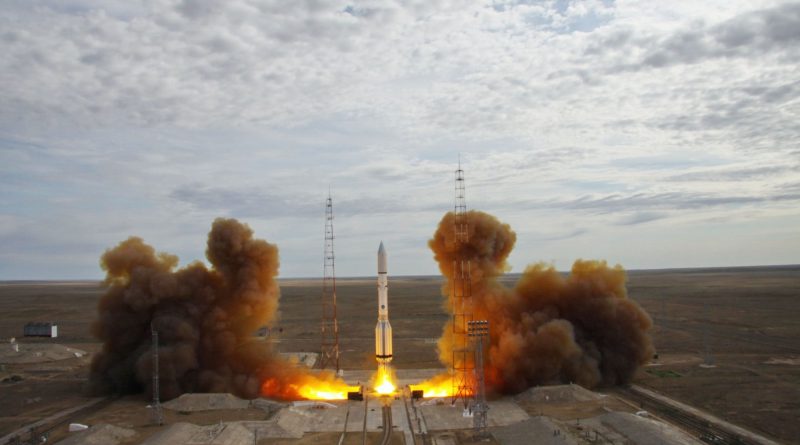Russia’s Proton Returns to Flight after Year-Long Grounding, sends EchoStar-21 to Orbit
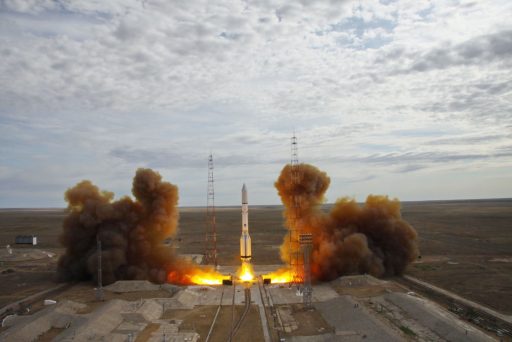
Russia’s Proton-M rocket soared into the skies over the remote Baikonur Cosmodrome again on Thursday, ending a year-long grounding with the launch of the EchoStar-21 mobile communications satellites – one of the vehicle’s heaviest Geotransfer payloads to date.
Proton’s year-long grounding was caused by major quality control issues related to the rocket’s engines that were discovered in the wake of a sporty mission when Proton last flew. Back on June 9, 2016 – almost a full year ago to the day – Proton made its first flight in its Phase IV evolution with increased payload performance and encountered a premature shutdown of one of its four second stage engines that cut out around nine seconds early and caused a shortfall in energy after the three-stage rocket was done.
The performance hit, unrelated to the Phase IV upgrade, was luckily corrected by Proton’s Briz-M Upper Stage and Intelsat 31 reached its planned orbit, but future missions were grounded until answers for the premature shutdown could be found.
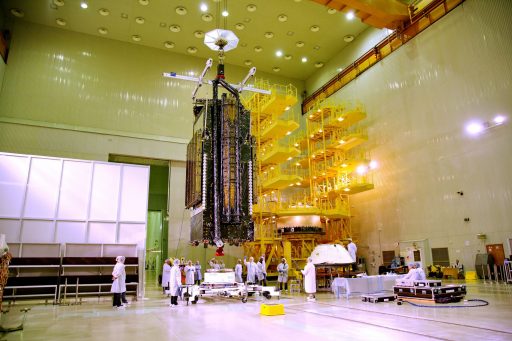
Roscosmos did implement a number of corrective actions and Proton was ready to return to flight in late December.
EchoStar-21, a 6,871-Kilogram S-Band communications satellite, had already taken its spot atop the Proton-M rocket for a December 28 liftoff when a problem with the rocket’s first stage prompted a delay into January to facilitate a component replacement that was to be done at the launch site.
But the January return to flight was not to become a reality when investigators looking into the failure of a Soyuz rocket found potentially troubling news for Proton.
The penultimate Soyuz U rocket lifted off from Baikonur on December 1st with the Progress MS-04 cargo spacecraft that was expected to deliver 2.4 metric tons of supplies to the International Space Station. However, the mission failed to reach orbit due to a catastrophic event during third stage flight.
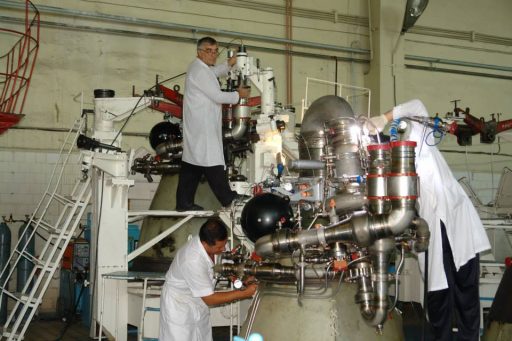
The problem was quickly narrowed down to the RD-0110 engine of the Block I third stage and investigators began scrutinizing engine manufacturer VMZ, Voronezh Mechanical Plant. Investigators found the likely cause of the Soyuz failure was a manufacturing defect on the engine’s high-pressure oxidizer pump, but the probe also revealed the reason behind persistent issues with Proton’s second and third stage engines that are also manufactured at VMZ.
Proton’s engines are produced in batches and a non-flight engine of each batch is acceptance tested in a hot-fire test to clear a particular batch for shipment to the launch vehicle manufacturer. The use of highly corrosive hypergolic propellants does not allow flight engines to be test fired. Although the engine held up during the test, post-firing inspections showed notable deficiencies within a solder joint.

Investigators found that the solder joint connecting the Gas Generator with its fuel injector did not use the material specified for Proton’s production and instead used the material employed on the Soyuz RD-0110 which has a lower melting point – potentially creating a weak-point in a critical engine component where liquid propellants turn into a high-pressure, super-hot gas that drives the engine’s turbomachinery.
It was determined that only a small quantity of the wrong material had ended up in Proton’s engine production line but tracing down the engines built with the potential defect proved out impossible.
As a result, 71 engine for 14 rockets – produced between 2015 and 2016 – had to be recalled for disassembly, replacement of the gas generator, re-assembly and acceptance testing – a time consuming process that will take the remainder of 2017, but the first refurbished engines were shipped to Proton builder Khrunichev as early as March, allowing launchers to be re-fitted with hopefully trouble-free engines.
Proton’s third stage in particular had been a trouble causer in recent years with failures in 2014 and 2015 that claimed the loss of the Ekspress AM-4R and MexSat-1 communications satellites. Instrumentation added to the steering engine of Proton’s third stage between these failures finally revealed that a marginal mechanical joint on the turbopump and the rotor material within the pump showed deficiencies when subjected to maximum operating environments. Proton had flown with these potential issues for decades and a 1988 failure is suspected to have been caused by the same condition.
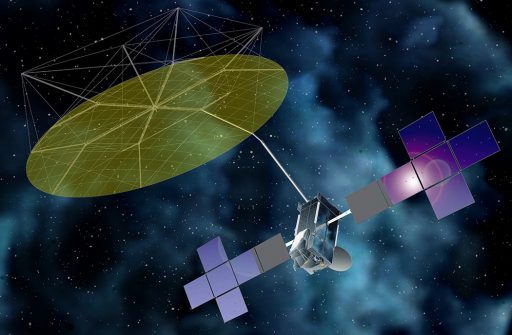
Fitted with new engines on its second stage and using a third stage engine without a built-in defect, Proton returned to the Baikonur Cosmodrome in early May to resume the EchoStar-21 launch campaign after a five-month break. EchoStar-21 was kept safe throughout the delay and was finally able to take its spot atop the Briz-M upper stage before being integrated with the rest of the launch vehicle for rollout Monday morning.
EchoStar-21 is one of the heaviest payloads ever lifted by the Proton on a Geostationary Transfer Mission, hosting a powerful S-Band antenna reflector that will deploy once the satellite reaches Geostationary Orbit to deliver hundreds of spotbeams to carry voice & data communications, as well as monitoring and messaging, leveraging the 3G air interface standard.
>>EchoStar-21 Technical Overview
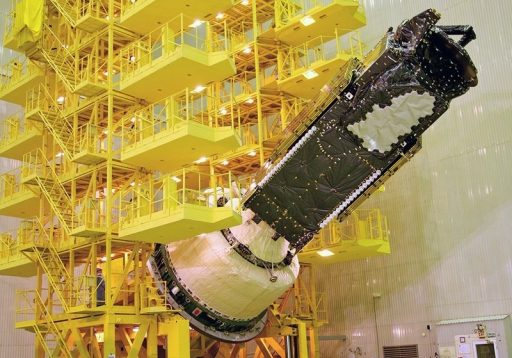
The spacecraft was originally ordered for TerreStar’s network that planned two satellites over the U.S. and Europe, the first of which launched in 2009 and took up station to serve the Americas. TerreStar ordered the second satellite back in 2006 and EchoStar acquired TerreStar Network’s assets in 2012 including the satellite already in orbit and the satellite being manufactured for an original launch date in late 2015.
The EchoStar 21 satellite will reside at 10.25° East with a planned lifespan of 15 years, carrying various mobile communications services including EchoStar Mobile’s all-IP enabled communications network.
Thursday’s launch ended the longest gap in Proton launches since the rocket’s debut in 1965, coming 364 days after the vehicle’s most recent launch. Previously, the longest gap between two Proton missions was nine months between the retirement of the original UR-500 and the improved Proton-K back in the 1960s.
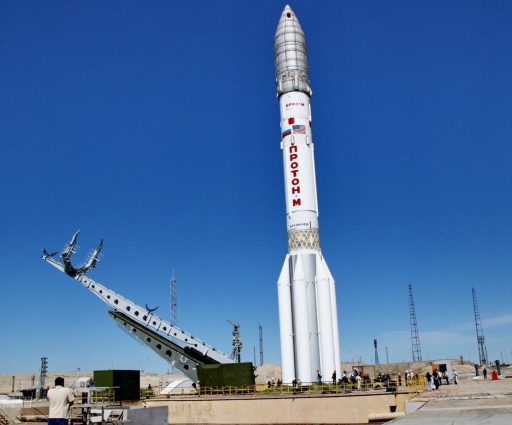
Standing 58 meters tall atop its launch pad, Proton headed into a long all-night countdown of 11.5 hours that reached its final phase as sun came up over the Baikonur Cosmodrome on Thursday.
Countdown operations started with the activation of the Briz-M for a final sequence of complex testing before uploading the planned nine-hour flight sequence to the upper stage. Proton was powered up around seven hours prior to launch for a last set of checkouts.
With the green-light given by the Russian State Commission, non-essential workers departed the launch pad for the three-hour fueling sequence at T-6 hours, loading the hypergolic monster with 622 metric tons of toxic Unsymmetrical Dimethylhydrazine and Nitrogen Tetroxide.
After fueling was complete, the launch pad was re-opened for the finishing touches on the Proton launcher and ground facilities as the rocket was revealed on its pad 75 minutes before T-0 when the large Service Structure was moved to its launch position. In the run-up to terminal countdown, EchoStar-21 transferred to battery power and all stations reported readiness for Proton’s Automated Countdown Sequence.
>>Proton-M/Briz-M Launch Vehicle Overview
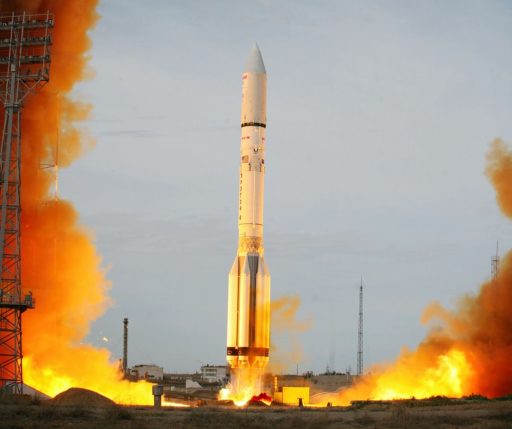
Over the last minutes of the countdown, Proton and Briz-M switched to internal power, pressurized their tanks and assumed control over the countdown at T-1:53 for a final automatic health check.
Proton came to life at T-2.5 seconds when self-igniting propellants were allowed to flow into the six RD-275M engines to begin driving their turbopumps to reach a collective liftoff thrust in excess of 1,000 metric ton-force. Liftoff occurred at 3:45:47 UTC when thrust on the engines overcame the weight of the Proton booster as no hold-down system is employed by the seasoned veteran of Russia’s space program.
Rising from its launch pad, Proton climbed vertically for the opening seconds of its flight before entering its roll and pitch maneuver to attain a 61.3-degree launch azimuth – the standard route toward GTO, taking the rocket toward the Kazakh-Russian border.
Consuming 3.6 metric tons of propellant each second of powered flight, Proton pushed through the sound barrier and encountered Maximum Dynamic Pressure just after passing the one-minute mark. By T+1 minute and 42 seconds, Proton only weighed half of what it did at liftoff, having burned the majority of the 419 metric tons of propellants held by its first stage at launch.
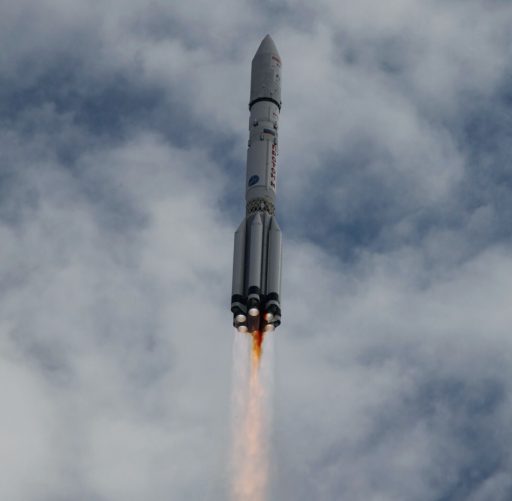
The first stage shut down as planned one minute and 59 seconds into the mission when the hot staging sequence kicked off with the ignition command to the four-engine cluster one the second stage, coinciding with the pyrotechnic separation of the 21.2-meter long first stage that was then pushed away by exhaust from Stage 2. Falling away from the stack, the first stage headed toward a crash landing 310 Kilometers from the launch site.
With its refurbished RD-0210/0211 engines up and running, the second stage continued pushing toward orbit with a three-minute and 28-second burn, generating a total thrust of 244,600 Kilogram-force. Throughout the burn of the second stage, real-time calls from the Launch Team continued to indicate stable parameters of the propulsion system and Proton heading downrange on a nominal trajectory.
Burning through 156,100 Kilograms of propellant, the second stage was also set for a departure in a hot-staging mode. The RD-0214 four-chamber vernier of the third stage started up at T+5:24 followed three seconds later by cutoff on the second stage and explosive-driven separation of the spent second stage.
The third stage pulled away under the power of its 31-Kilonewton vernier engine and the RD-0213 main engine fired up three seconds after staging to raise the third stage’s thrust to 63,000 Kilogram-force. Proton’s 14.5-meter second stage was headed for re-entry and impact 1,990 Kilometers from the launch pad.
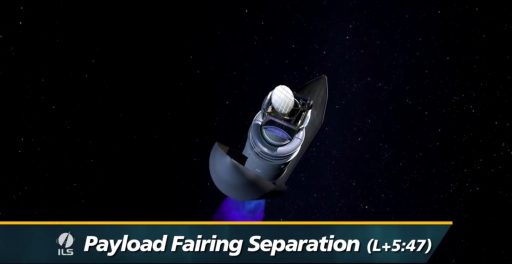
Twenty seconds after the third stage was handed control of the mission, Proton split open and separated its two payload fairing halves, having passed 100 Kilometers in altitude where aerodynamic forces could no longer harm the EchoStar-21 spacecraft.
Proton continued flying down the expected trajectory and showed stable propulsion, according to real time calls made by the Baikonur Launch Team. Main engine shutdown occurred nine minutes and 31 seconds into the flight while the vernier continued burning for another ten seconds to finish Proton’s task of placing the Orbital Unit on a sub-orbital trajectory.
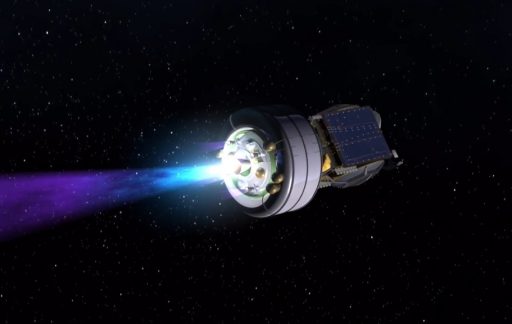
Nine minutes and 42 seconds after liftoff, the Briz-M upper stage separated and assumed control of its nine-hour, five-burn mission profile – also marking success for the three-stage Proton.
Immediately after separation from Proton, Briz-M stabilized its orientation and coasted passively for one and a half minutes to gain altitude before firing up its 2,000-Kilogram-force S5.98 main engine 11 minutes and 15 seconds into the mission, preceded by the usual propellant settling maneuver using the high-pressure thrusters to ensure the main engine would not ingest any gas bubbles.
The first burn of the Briz-M upper stage was planned to be 4 minutes and 17 seconds in duration to lift the stack into a Parking Orbit of 168 by 179 Kilometers at the standard inclination of 51.5 degrees. Briz-M was programmed to automatically correct insertion errors by Proton to reach the planned initial orbit.
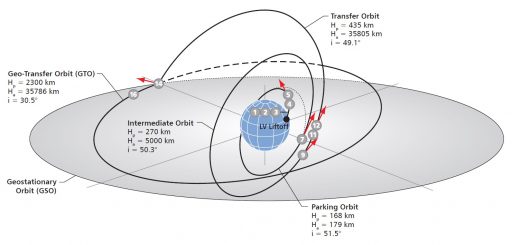
At the conclusion of the first upper stage burn, the stack entered a coast phase of 52 minutes so that the second burn could occur on the ascending node and position the high-point of the transfer orbit over the equator on the opposite side of the planet. Firing up one hour, seven minutes and 24 seconds into the mission, Briz-M was set for a lengthy burn of 17 minutes and 56 seconds to lift the apogee of the orbit.
The second firing of the Briz-M stretched from the Pacific Coast of South America, across a large stretch of the Atlantic Ocean and North Africa with shutdown just before a pass over the Mediterranean – occurring out of view from Russian Ground Stations. This firing aimed for an orbit of 270 by 5,000 Kilometers, 50.3 degrees.
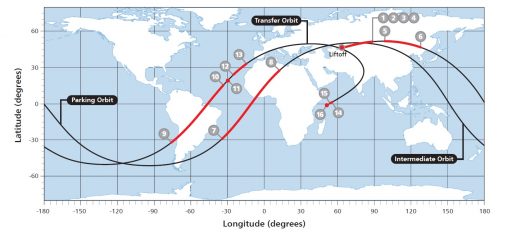
Due to the relatively low performance of the Briz-M engine, orbital mechanics do not allow an economical raising of the apogee in a single pass given the long burn duration that would be necessary.
Therefore, Briz-M had to make two apogee-raising maneuvers, separated by a coast of nearly an entire orbit. The third burn was programmed to begin at T+3:27:59 with a duration of 9 minutes and 37 seconds after which propulsive flight paused briefly for the separation of the Auxiliary Propellant Tank that had depleted its propellant load of 14,600kg at that point of the mission.
The fourth burn was programmed to commence at T+3:40:01 and last seven minutes and 52 seconds to place the orbital unit in an orbit of 435 by 35,805 Kilometers, inclined 49.1 degrees. The 2/3 burn pair stretched from a position over the Pacific to just of the north-western coast of Africa with APT jettison taking place over the Atlantic.
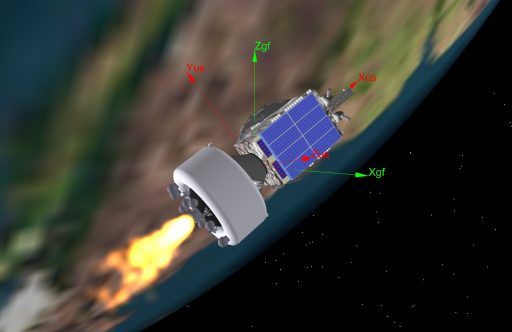
Next, Briz-M settled in for its longest coast phase of just over five hours to be able to climb all the way up to apogee.
The fifth and last main engine burn planned on Thursday was expected to commence eight hours, 52 minutes and 58 seconds into the flight and served as a perigee-raising maneuver and plane change (inclination reduction) both intended to cut the amount of propellant needed by the satellite to maneuver into GEO. The burn had a planned duration of 4 minutes and 26 seconds and targeted EchoStar’s injection orbit of 2,300 by 35,786 Kilometers, inclined 30.5 degrees to either side of the equator (GEO-1,778m/s).
According to Proton’s commercial operator International Launch Services, all five burns of the upper stage went according to plan and the intended orbit was reached.
Spacecraft separation was confirmed nine hours and 13 minutes after the day’s liftoff, at 12:58 UTC on Thursday – sending EchoStar-21 on its way to complete a series of apogee maneuvers to enter Geostationary Orbit and begin a 15-year mission serving Europe. Briz-M will be tasked with a pair of disposal maneuvers to maneuver into a graveyard orbit.

